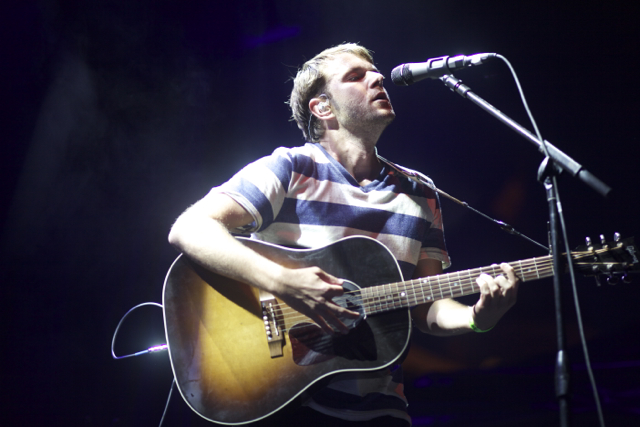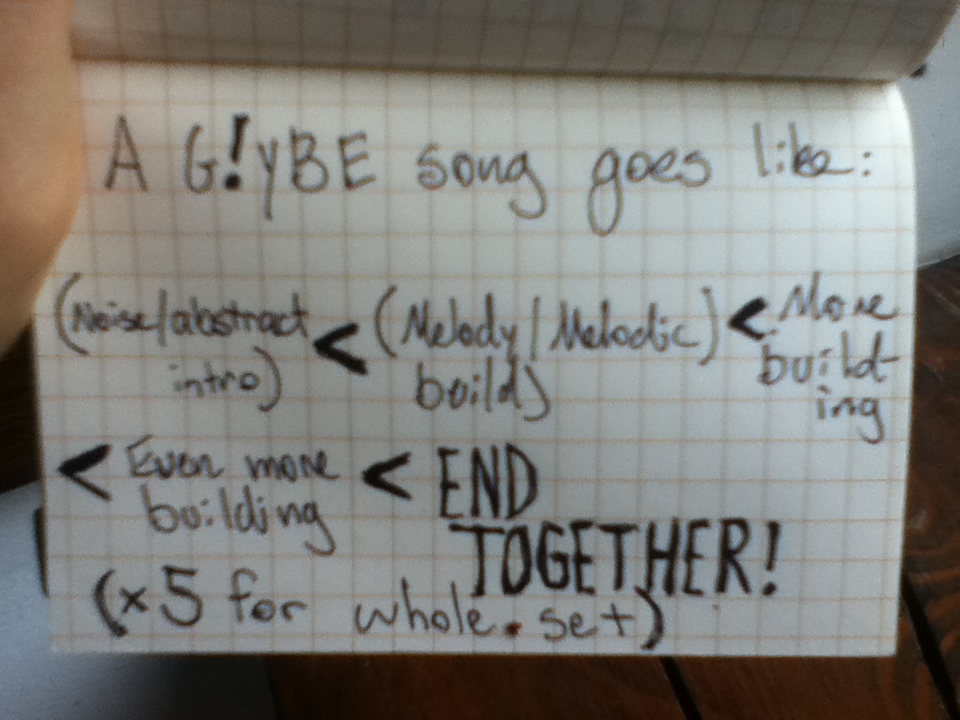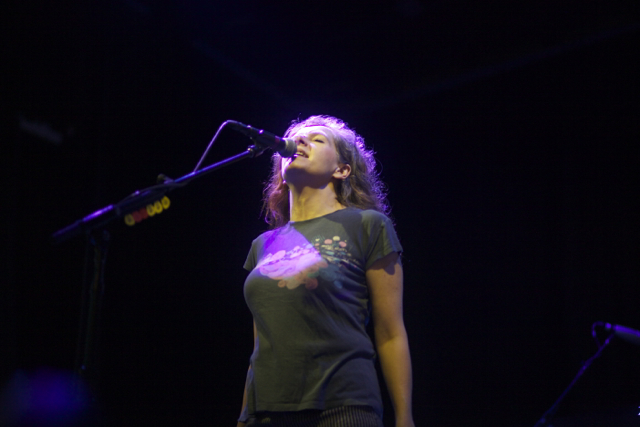People being people around people for people
Probably my favorite thing I’ve experienced at any MFNW was hearing Will Cullen Hart of Olivia Tremor Control yell, “Go listen to the record!” to a fan requesting “At The Opera House” during their reunion show in 2011. Taken out of context, it sounds malicious, but besides having a good point, it represented a simplified idea regarding what live performance should be in an age of retaining predictability. Along this theme, I had a great conversation with four strangers while waiting in line (and eventually missing) Chromatics, discussing what live experience meant to us, whether it was in the right and requirement of Animal Collective to play “My Girls,” or if experiencing a Swans set amounts to reliving gym class or not. If musical experience is often denoted as ineffable (or at least, on spoken terms, in the realm of “it was so so so good”), does our notion of ineffability hinge on expectation?
As for myself, not being a good person around people I often didn’t feel good about being around, I enjoyed some things with as much joy and spirit as those I was around. Attending shows alone is for over-thinkers and weirdoes, or at least being forced to be left alone with your own observations in a crowded room doesn’t really fit conventional notions of crowd gathering.

Thao and the Get Down Stay Down (Photo: Kirsten Pardun)
Still, surrendering oneself to a notion of “connectivity” doesn’t fit the experience. Even in a crowd, among strangers, live experience still seems to me to remain a solitary act reliant on social acknowledgment post-experience. The event seemed to define the moment rather than the sound, and my observations might have been influenced by my own judgments and anxieties, but between the pomaded blonde guy in a wife beater who, before Glass Candy exclaimed, “Who are we seeing again?” Who then as soon as the sound started pushed by me to shove himself as close to the stage as possible, phone in hand taking pictures and video being shaken by those surrounding trying to form a dance space, themselves enclosed by three large cross armed dudes, two of which were overseeing their dancing girlfriends. Heavy electronic beats, sweat, and sex dominated the atmosphere, and as much as I wished everyone could be like the two boys I saw kissing and dancing, I was as much surrounded by half-interested parties.
During both Lonnie Holley and Deerhunter, I experienced more chatter and phone pictures from the 21+ side than the all ages half of the Crystal Ballroom, and for the majority of Deerhunter’s set I was next to another girl who stayed on her phone for the entirety of their show until her friends gave up on their long form noise pop jams and left. This before the band could perform an incredibly long and ear-splitting version of “Monomania,” which made their much discussed at the time Fallon performance seem more like a throwaway joke than an event in their personal lexicon. From a space in the back, I saw the crowd of active networkers and chatters scatter during Deerhunter’s 30-minute-long single beat, kraut-noise pop “encore.” I found myself impressed beyond expectation for a band that (and for all expectations of Bradford Cox to behave notoriously) was as cohesive as they were unpredictable. The next day, a reporter for Portland’s Willamette Week attested to seeing a bored James Mercer in the VIP area.
What happened?

The Head and the Heart (Photo: Kirsten Pardun)
Some specifics are in order. There are things that happened at these events, and although I can’t compete with live-by-the-minute tweets or the fact that the festival happened over a week ago (meaning almost everything has already been “reported”), I can give some specifics.
– Will Oldham pulled up someone from the crowd who had requested “Agnes, Queen of Sorrow” to sing it with him (to which the crowd watched this stranger conquer anxiety and limited pitch range). In our seats, when the darkness of Oldham’s tunes hushed out laughter from his divine comic posturing, I laughed and clapped with people whose conversations I’d been eavesdropping on. Oldham apparently hates Amazon, disdains Apple, and disowns Facebook in eloquent terms, pertaining to his belief that we shouldn’t necessarily get the things we want in the moment we want it, even if it means his own album. His analogy to Invasion of the Body Snatchers seemed neither condescending nor down-spoken, but rather the back door of humor that should instill some form of the old religion’s guilt once a body exits the building and logs in.
– Glass Candy was Ida No and her backing dancers inciting chaos at the Wonder Ballroom by surfing into a crowd whose half-life density began at about 20 feet away from the stage, forcing everybody who had kept their relative distance to pile in with everybody else so the three of them would stay afloat. Strangers being pulled onstage, a single whoever jumping on the crowd surfing idea, and another person being surfed in the crowd which piled onto the stage.
– In the under-21 side of the Deerhunter show at the Crystal Ballroom, I watched a few kids split a flask by way of the paper conical water cups offered in the back of the venue and, at least without much vocal expression, try to find their way through and enjoy Lonnie Holley’s 40+-minute, single-song set.

Animal Collective (Photo: Kirsten Pardun)
– Even with a sign that said, “NO FLASH OR PRO PHOTOGRAPHY, NO VIDEO,” the Mount Eerie and Bonnie “Prince” Billy set was riddled with the occasional iPhone flash, and even from two pro photo guys who felt it so necessary to facilitate desire that they ignored the signs and went straight for the kill, one from the alley between seats towards the back, and another guy in the front. A guy in front of me was reminded of this by his partner the minute after he snapped a flash picture.
– As unable to express his desire without sounding like an asshole, Bradford Cox performs the notion of, “giving a fuck enough to try” better than he speaks it. Laying off the goofier Monomania songs like “Dream Captain” or “Pensacola” helps. What was probably the best set of musicians playing together in a room I saw, it was a great reminder that Deerhunter is a garage band that at least bothers to translate.
– As much noise and drone as Michael Morley playing as Gate could muster couldn’t drown out the crowd chatter, even from my space directly in front of the side-stage speakers.
– Mount Eerie songs have perfect endings, every single on of them. This is accentuated one time by Phil Elverum, who stuck out his hand to stop it mid-air. The motion reminds me of this facet of his music, the space between continuance and resolution — no fade out, only suspense in complete form.
A GY!BE song and set performed live looks like this:

Rather than finding a way to take a repetition and dwell in it, Godspeed You! Black Emperor performed every song in a structurally repetitious way, which became inherently predictable halfway through, feeling less adventurous than their albums and even somewhat crowd pandering once the melody of “East Hastings” cut in toward the end. There is such a thing as repetitious and unpredictable. This wasn’t it. Someone held up a phone while video of Wall St. stock exchange numbers and protesters flashed behind the group. I felt more sympathetic toward the girl who shoved her way as close to GY!BE as she could in order to engage in some overly enthusiastic head banging and aggressively air punching during a mid-level dynamic.
A few of the venues involved:
Quick note first: An all-access wristband runs between $90 and $150, yet it guarantees absolutely nothing. Individual tickets to shows guarantee access, and with no notion of knowing how many people will have bought tickets to a specific show or how a venue will run their “capacity” numbers (in the Chromatic line, I was told that I’d both never and easily get in by the venue’s employees), it almost seems better to just buy a few tickets to the things you really want to see.

Neko Case (Photo: Kirsten Pardun)
– Pioneer Square, an open-brick public space that houses a Starbucks and a bronze statue of an old man holding an umbrella. “Big Events” happen here, and in the same year that Red Bull hosted a skateboarding competition, another skateboarder was beaten severely by the square’s hired security. The “Big” shows (Animal Collective, Neko Case, some other band I can’t remember) happened here. A very small glass of wine will run you $6. It’s not worth it.
– A majority of the “garage”-related bands played at a venue called Dante’s, which might be one of the more embarrassing places in Portland. Decorated somewhere between the SparkNotes version of Inferno and Brian Setzer’s back tattoo, it has terrible sound with flames shooting out of shit. Every time this place undergoes a redecoration, it digs itself deeper into whatever hole it’s created. I’ve seen great shows here.
– The Old Church is exactly as it’s named: an old church. “Softer” or more “acoustically acquainted” acts play here, and it sounds beautiful.
– The Roseland, which usually hosts hip-hop acts (this year, Joey Bada$$ and Antwon), also hosted the Gate/Earth and GY!BE shows. I was frisked for guns or knives here by security. The sound here, for the most part, is terrible.
– Portland owning-stuff giants McMenamins operate the Crystal Ballroom, which was originally built for jazz before the great depression. Falling to persecution and moral panic, it was bought by a man named Dad Watson in the 1920s, who then turned it into a square dance venue. It remained this way until desperation from lack of revenue set in, and in the early 60s, it hosted R&B acts such as James Brown, Marvin Gaye, and Ike and Tina Turner. Around the same time, it became a spot for psychedelic and garage bands both regional and national — The Grateful Dead, Holy Modal Rounders, The Redcoats, The Electric Prunes, Le Sabres, Portland Zoo Electric Band, and The Warlocks (not the current band or the former Grateful Dead or The Velvet Underground iterations, but from the nearby suburb of Tigard). Apparently, this stopped in 1968 due to concerns over the effects of “this music” on the Portland area youth. It became a part of the National Historic Registry in 79, at the same time during which it housed squatters. McMenamins bought it in 1997, and I saw Deerhunter here.

Deep Sea Diver (Photo: Kirsten Pardun)
– The Aladdin Theater has seats and was the only place in which I could actually see the performers.
– Thanks to the ticket vs. wristband discrepancy at the Wonder Ballroom I missed Chromatics, the only band I arrived early for. Much like the Crystal, the Wonder Ballroom is one of the sweatiest venues around, giving the red-only stage lighting and fog shadow beginning of Glass Candy an emphatic mystery I willingly fell for.
And a farewell to those I missed: Angel Olsen, The Men, Ty Segall and Mike Donovan (actually, I tried at this one, but the line extended around the block with Segall, the closer, fully intelligible from outside), Charles Bradley, Animal Collective, Black Bananas, Neko Case, Titus Andronicus, Bob Mould, White Lung, Earth, Le1f, and the Anti-Fred Armisen protest (which apparently never took place due to rain). Maybe it was Oldham’s power of persuasion or charm, but I’m feeling better for knowing that I missed more than I was able to see. I could have given up the possibility of seeing Chromatics for The Thermals, but doing so would have been like stopping sex to watch Everybody Loves Raymond. Sometimes the effect an event can have on our senses has as much power as a “Blake-ian notion” of excess/wisdom or, in turn, the insistence of being in one place at one time for as long as allowed by the venue operators being its own excess.
